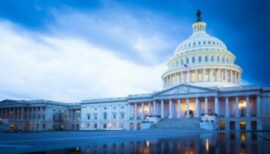Schools
Elementary School Designed to Withstand Tsunami
Westport, Washington

Infrastructure supports our economy and our way of life. In Washington, our infrastructure allows us to thrive in diverse climates and topographies. Our transit systems, including the largest ferry operation in the U.S., allows us to inhabit islands in Puget Sound and off the coast, while our road and bridge maintenance programs facilitate the necessary repair of infrastructure in climates ranging from temperate rainforests to dry deserts. Our infrastructure also protects our pristine natural resources from human development.
Unfortunately, infrastructure and the important role it plays can sometimes be overlooked — pipes deliver clean water, our light switches work as they should, and clicking “purchase” on our goods and services ensures they’ll be at our doorsteps within two days. We only pay attention when things break down or stop working as they should. Reliable and safe infrastructure requires sufficient investment, thoughtful planning, and preparation for the future. For a long time, underinvestment at all levels of government threatened our competitive advantage and the health, safety, and welfare of our residents. Fortunately, the state and many local governments have taken recent measures to provide additional support for our infrastructure. While the new funding and higher prioritization are welcome, additional steps can still be taken to ensure Washington’s infrastructure is fit for the future.
The Report Card was created to help Washington understand the state of our infrastructure. As civil engineers, our job is to plan, design, construct, and maintain our infrastructure networks. This document allows us the opportunity to share that information with the public. The Report Card provides a snapshot for residents and policymakers to engage in a conversation about where we are and where we want to be. We hope that this information provides the insight needed to start that conversation and ignite action.
Click here to read the 2019 Report Card for Washington’s Infrastructure executive summary.
Each year, more than 25 million passengers and 600,000 tons of cargo are transported through the Washington state aviation system. Aviation is critical to the economy of Washington, the home to many global companies including Amazon, Costco, Microsoft, and Boeing. The aviation system has provided more than 300,000 jobs, $16 billion in wages, and $64 billion in total economic activity annually. While the future is bright, planned improvements must be realized before traffic demand exceeds capacity. WSDOT estimated that $3.6 billion is needed to grow and sustain Washington’s 134 public airports during the next 20 years. Seattle–Tacoma International Airport (Sea-Tac) faces significant capacity challenges, but a new international arrivals facility will help accommodate passenger growth and enhance air traffic.
Washington is home to 7,410 vehicular bridges. Of these, 321 bridges are in poor condition, which equates to 6.6% of the inventory based on bridge deck area. In 2017, there were 4,979 bridges in need of repair. This includes replacing deteriorated bridge elements such as floating bridge anchor cables, repainting steel bridges with a protective paint coating, and repairing concrete bridge decks. Additionally, there are 590 bridges that require a seismic retrofit in order to meet current earthquake design standards. The Washington State Department of Transportation (WSDOT) is implementing new bridge innovations — such as accelerated bridge construction (or ABC) techniques — to reduce construction time and bridge lifecycle costs. However, more funding is needed to perform necessary operation and maintenance work, repairs, retrofits, and replacements of existing bridges to keep Washington’s infrastructure functioning.
There are 1,130 dams in Washington, 39% of which are categorized as significant- or high-hazard dams. Most of Washington’s dams are regulated by the Washington State Department of Ecology Dam Safety Office and are privately owned. Washington’s dams are generally in acceptable condition, but some are aging and do not meet current seismic standards. Some dams have safety deficiencies and are considered unsatisfactory, but do not pose an imminent threat to public safety. Emergency action and operation and maintenance plans have been prepared for 90% of the state’s high-hazard dams, compared to 77% nationally. Although the number of state-regulated dams per full-time DSO employee is considerably better than the national average, staffing numbers still fall short of recommended levels. Additionally, available funding has dropped; the DSO budget was $1.1 million in 2017, down from $1.33 million in 2011. Aging dams, coupled with a lack of a funding program for the repair of private dams, continues to be a challenge. Moreover, as new seismic designs and code updates are adopted, funding needs will continue to grow.
Community public water systems (PWS) provide water to more than 6.28 million of Washington’s 7.31 million residents. The remaining population is served by private systems, including individual water wells. There is a clear divide between the well-funded large- to medium-sized PWS versus the small to very small PWS. While large PWS comply with water quality regulations, meet water supply, and maintain and operate their infrastructure effectively, smaller PWS are having difficulty satisfying all regulatory requirements on a consistent basis. Washington State will need approximately $11.73 billion over the next 20 years to keep up with the growing demand and aging transmission, distribution, treatment, storage, source, and other related infrastructure. Deferred capital reinvestment and emerging infrastructure resiliency demands are contributing to the growing funding needs. Washington is not alone in this situation, as other states across the nation are experiencing similar funding shortfalls.
The Puget Sound region is experiencing the largest annual population increase in the nation. There was a 3.11% growth in population between 2015 and 2016, in part thanks to the continuing tech boom. Annual vehicle delay along major Washington highways increased by up to 173% between 2014 and 2016. While capacity remains a major challenge, the condition of roadways is improving. Currently, 92% of the Washington State Department of Transportation’s pavements are in a fair and better condition, meaning the state is exceeding its goal of 90%. Some local agencies are starting to see an increase in their pavement condition ratings as well, and are greatly benefited by the Washington State Transportation Improvement Board grant program. Operation and maintenance costs are extremely important for the condition of our roadways. New capital projects need to be resilient to natural disasters. Even with innovations in roadway technologies, the lack of funding — especially from federal sources — hinders the state’s ability to catch up to the ever-growing needs.
Public schools are the backbone of our communities as they help provide our future generation with the education and social skills needed to contribute to the economy of the future. Washington’s 295 school districts range in size from four students to more than 53,500 students, with a total prekindergarten through 12th-grade student enrollment of 1.12 million in 2018. Washington State has recently increased funding to reduce class sizes to meet constitutional requirements. This is a positive step, but local districts now face a shortage of physical classroom space. Many communities have supported bond measures for new construction or modernization projects, but it will take time for these needs to be met statewide.
Washington state has 33 transit agencies that provide bus, ferry, and light rail service to more than 7 million residents. The greater Seattle area continues to lead the nation in transit ridership growth; ridership increased by 4.7% from 2015 to 2016, and a record 122.2 million riders used transit in 2017. In 2016, voters approved a major expansion of Sound Transit’s transit network, which will add 110 miles of light rail service to the Puget Sound region by 2040. However, in rural areas outside of urban and suburban centers there is less demand for transit to support adequate funding and quality service. Meanwhile, the state will continue to experience significant challenges due to population growth, regional geographic and geologic hazards, transit safety, limited funding, and equitable access. Transit is a vital solution to many of these challenges and is instrumental to Washington’s economic success. Transit infrastructure needs to be improved, maintained, and expanded.
Washington State is a leader in innovative and sustainable methods for managing stormwater as its own separate resource. Within the last decade, many cities and counties have taken proactive steps to manage stormwater and the impacts that development has had on our natural environment. King County recently began construction on a $262 million treatment plant to handle large combined sewer flows in the Duwamish River basin, which will treat a great deal of polluted stormwater. The City of Tacoma completed its Point Defiance regional stormwater treatment facility project in 2016. This facility treats storm runoff for a large basin in the North Tacoma neighborhood and protects a sensitive part of Puget Sound. The City of Seattle has started construction on a $570 million combined sewer overflow storage project to reduce untreated stormwater and wastewater flows to the Lake Washington Ship Canal. While the concept of stormwater management is relatively new, much of the stormwater infrastructure itself is beyond its design life and in need of repair or replacement. Asset management practices, along with study and preparation for a changing climate, will be critical to making infrastructure funding decisions about how best to manage limited dollars for investing in deteriorating systems in the coming years.
Washington State has approximately 250 wastewater treatment facilities that serve close to 6 million residents. Wastewater systems generally consist of collection systems, treatment facilities, and outfalls to receiving water bodies. These systems vary in size and ownership across the state. Most utilities and treatment works are publicly owned and operated. The remaining population is served by privately owned, on-site septic systems. Washington’s wastewater utilities project an increase of 40% in population served by treatment works by the year 2032, to approximately 8.3 million people. Most of the state’s wastewater systems are beyond their design life and the conveyance networks as a whole are in poor condition. The condition of privately owned sewer assets, such as side sewers and septic systems, is also a problem. The capacity of sewer networks is of growing concern and, as densification occurs, older parts of the system struggle to accommodate the higher flows. Despite barriers in funding and public opposition to increased rates, the state’s wastewater systems are doing a fair job of keeping the public safe and healthy and protecting our environment.
A: EXCEPTIONAL, B: GOOD, C: MEDIOCRE, D: POOR, F: FAILING
Each category was evaluated on the basis of capacity, condition, funding, future need, operation and maintenance, public safety, resilience, and innovation

Aviation
$17.4 million in 2022 airport improvement grants across 11 major airports

Drinking Water
$16.3 billion total drinking water need

Transit
120 million passenger trips across 63 systems in 2021

Bridges
8,358 bridges, 4.8% of which were structurally deficient in 2021

Hazardous Waste
69 Superfund sites

Wastewater
$4 billion total wastewater need

Dams
417 high hazard dams

Levees
659 miles of levees protect 210,300 residents and $11 billion of property.

Roads
58% of roads are in poor or fair condition
Smart investment will only be possible with strong leadership, decisive action, and a clear vision for our nation’s infrastructure.
If the United States is serious about achieving an infrastructure system fit for the future some specific steps must be taken, beginning with increased, long-term, consistent investment.
We must utilize new approaches, materials, and technologies to ensure our infrastructure can withstand or quickly recover from natural or man-made hazards.

FAA reauthorization bill circles for landing as lawmakers release bicameral deal
May 02, 2024
Congress started the week strong, as transportation leaders in the House of Representatives and Senate released the proposed text of a compromise to reauthorize the...
 Link to Post:https://infrastructurereportcard.org/local-officials-engineers-herald-seattles-multimodal-terminal-at-colman-dock-at-latest-roadshow-stop/">Local Officials, Engineers Herald Seattle’s Multimodal Terminal at Colman Dock at Latest Roadshow Stop
Link to Post:https://infrastructurereportcard.org/local-officials-engineers-herald-seattles-multimodal-terminal-at-colman-dock-at-latest-roadshow-stop/">Local Officials, Engineers Herald Seattle’s Multimodal Terminal at Colman Dock at Latest Roadshow StopApril 03, 2024
On Wednesday, April 3rd, the replacement project for Seattle’s Multimodal Terminal at Colman Dock, one of the world’s busiest ferry terminals, was showcased by local...

What the first round of FY2024 appropriations bills mean for infrastructure
March 07, 2024
On March 3rd, top lawmakers unveiled the text of six fiscal year (FY) 2024 appropriations bills that President Joe Biden signed into law on March...